小白学Pytorch系列-- Torch API (5)
小白学Pytorch系列-- Torch API (5)

Math operations
Pointwise Ops
TORCH.ABS
计算输入中每个元素的绝对值。
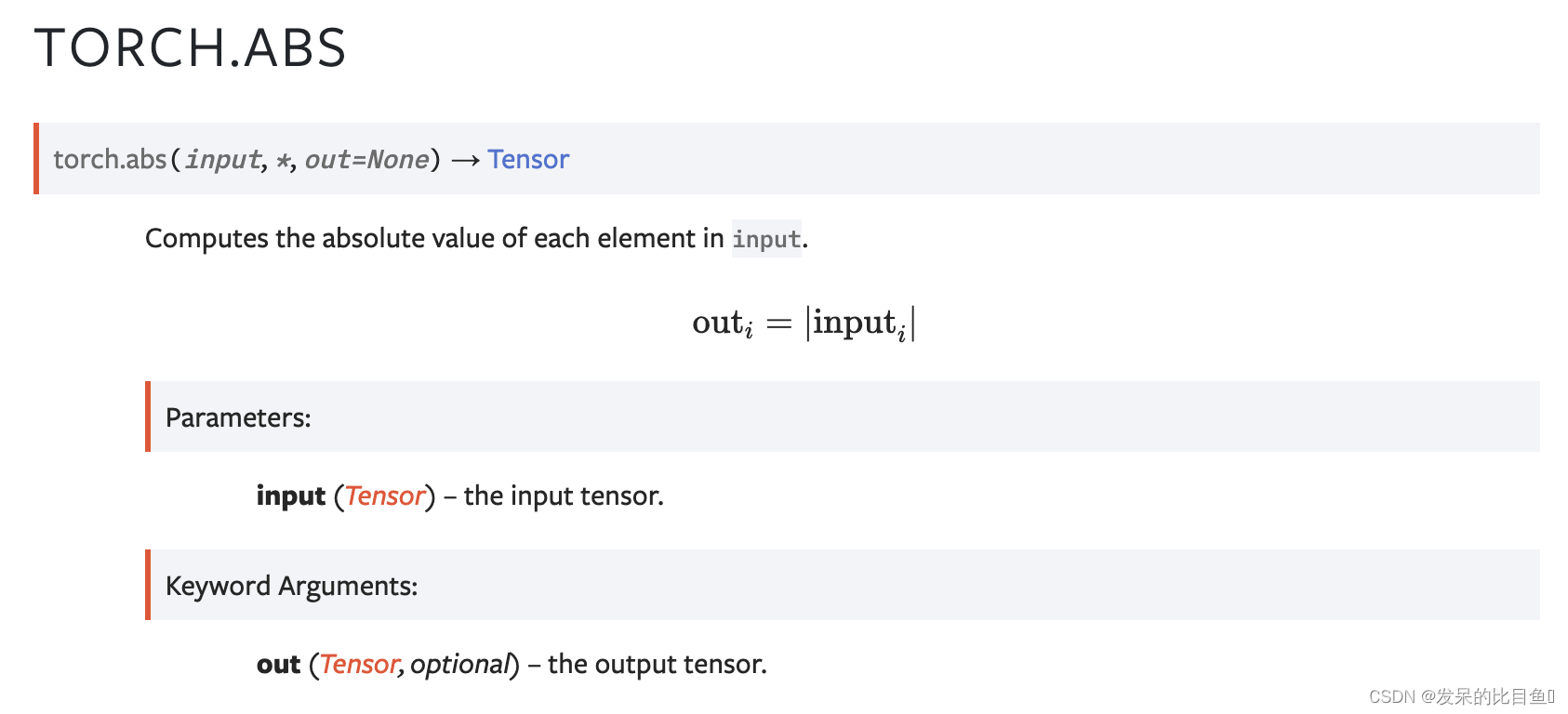
>>> torch.abs(torch.tensor([-1, -2, 3]))
tensor([ 1, 2, 3])
TORCH.ABSOLUTE
torch.abs() 的别名

TORCH.ACOS
计算输入中每个元素的逆余弦。
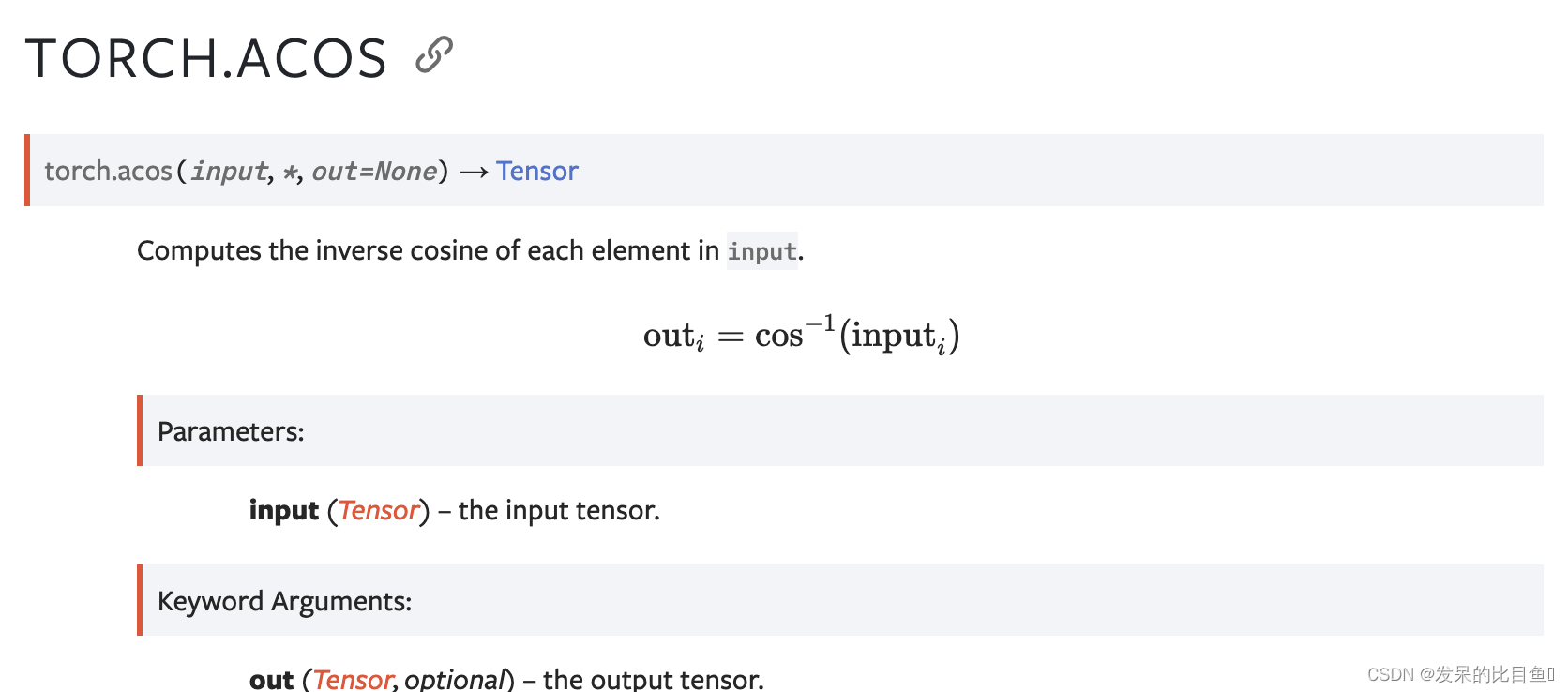
a = torch.randn(4)
a
torch.acos(a)
TORCH.ARCCOS
torch.acos()的别名。

TORCH.ACOSH
返回具有输入元素的反双曲余弦值的新张量。
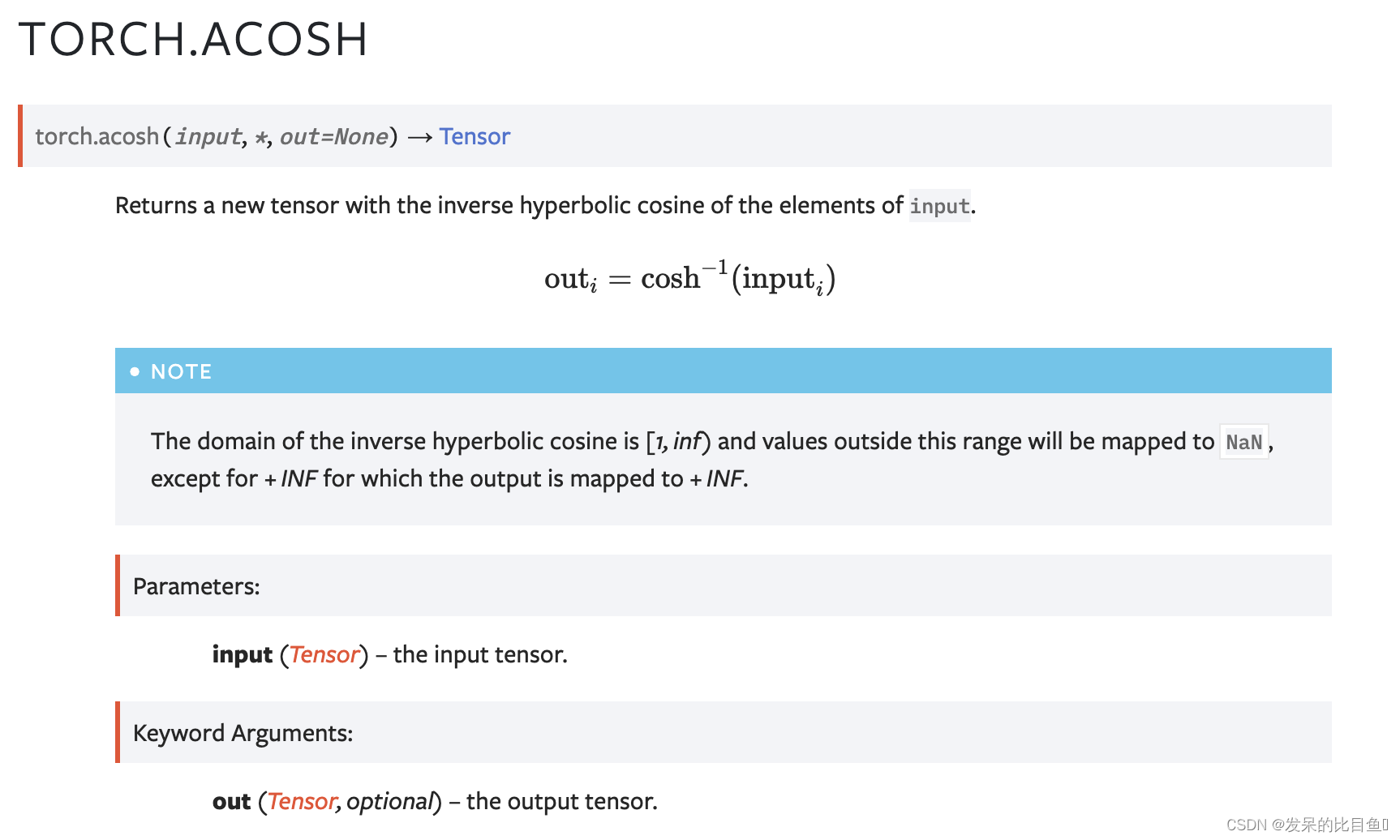
TORCH.ARCCOSH
Torch.acosh() 的别名。

TORCH.ADD
将按 alpha 缩放的other添加到input。
![]](https://img-blog.csdnimg.cn/992cd8fd81ba4b209a07df9c0a3360a0.png)
>>> a = torch.randn(4)
>>> a
tensor([ 0.0202, 1.0985, 1.3506, -0.6056])
>>> torch.add(a, 20)
tensor([ 20.0202, 21.0985, 21.3506, 19.3944])>>> b = torch.randn(4)
>>> b
tensor([-0.9732, -0.3497, 0.6245, 0.4022])
>>> c = torch.randn(4, 1)
>>> c
tensor([[ 0.3743],[-1.7724],[-0.5811],[-0.8017]])
>>> torch.add(b, c, alpha=10)
tensor([[ 2.7695, 3.3930, 4.3672, 4.1450],[-18.6971, -18.0736, -17.0994, -17.3216],[ -6.7845, -6.1610, -5.1868, -5.4090],[ -8.9902, -8.3667, -7.3925, -7.6147]])
TORCH.ADDCDIV
执行 tensor1 除以 tensor2 的逐元素除法,将结果乘以标量值并将其添加到input。
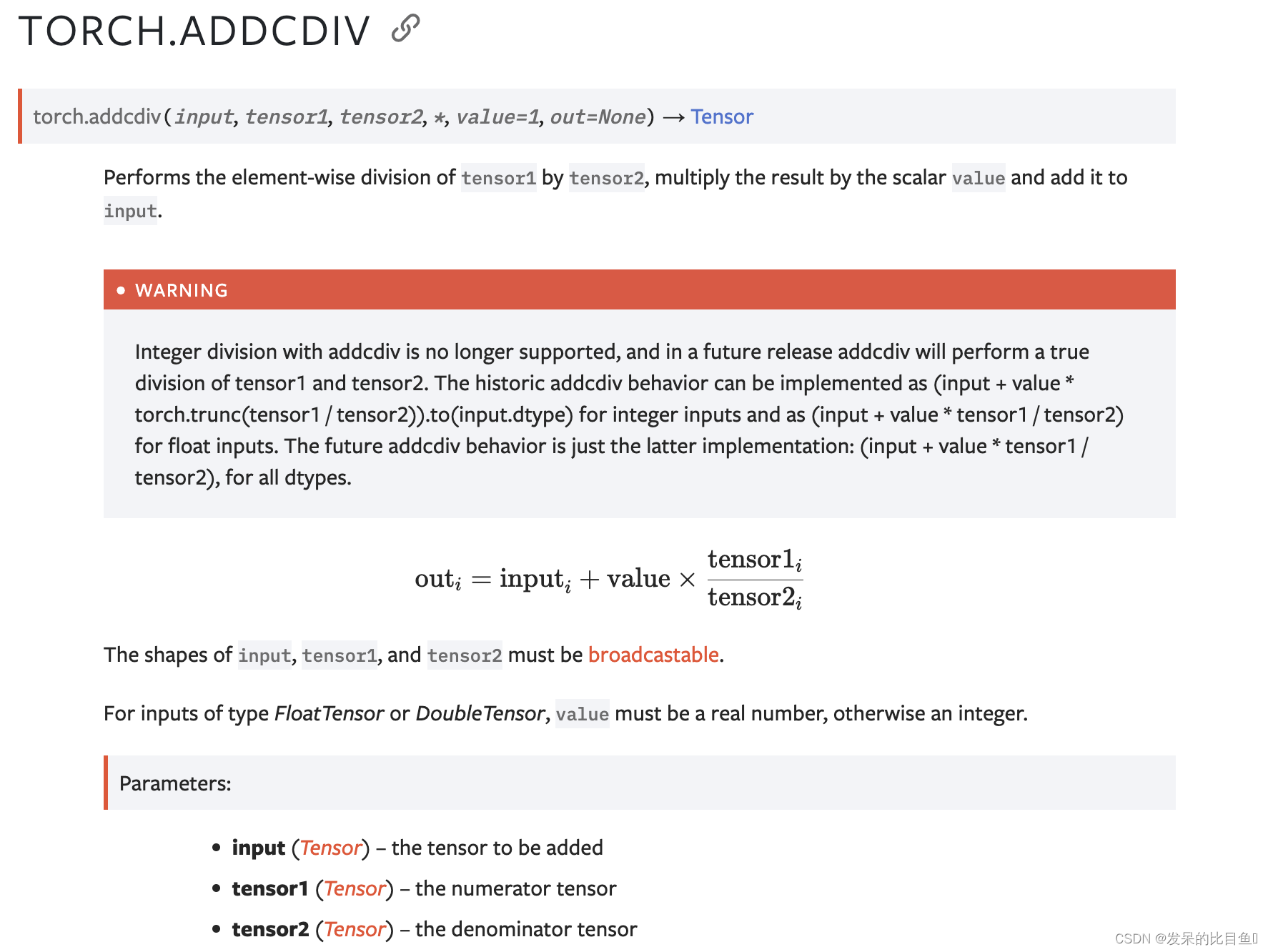
t = torch.randn(1, 3)
t1 = torch.randn(3, 1)
t2 = torch.randn(1, 3)
torch.addcdiv(t, t1, t2, value=0.1)
TORCH.ADDCMUL
执行 tensor1 与 tensor2 的逐元素乘法,将结果乘以标量值并将其添加到input。
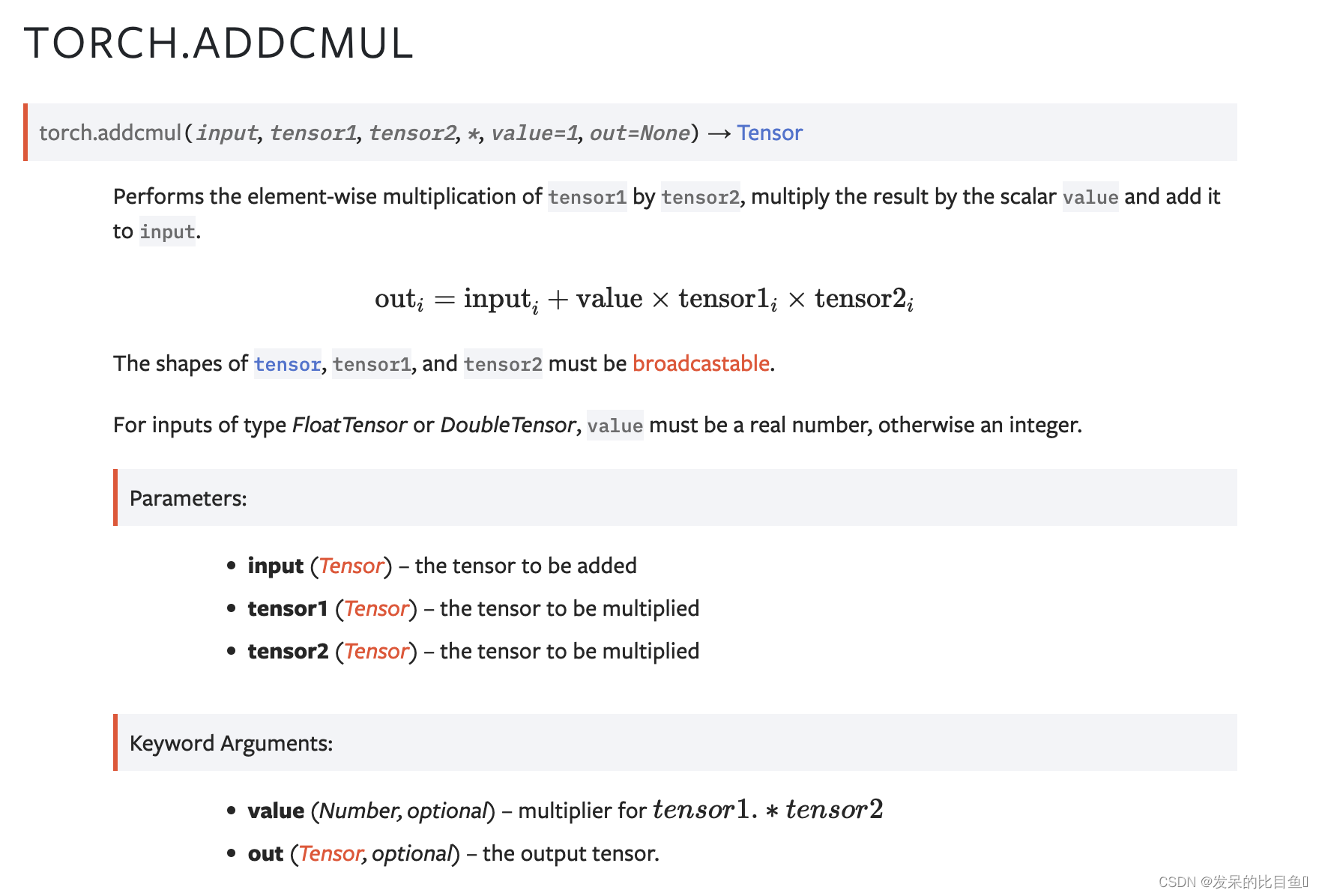
t = torch.randn(1, 3)
t1 = torch.randn(3, 1)
t2 = torch.randn(1, 3)
torch.addcmul(t, t1, t2, value=0.1)
TORCH.ANGLE
计算给定输入张量的元素角度(以弧度为单位)。
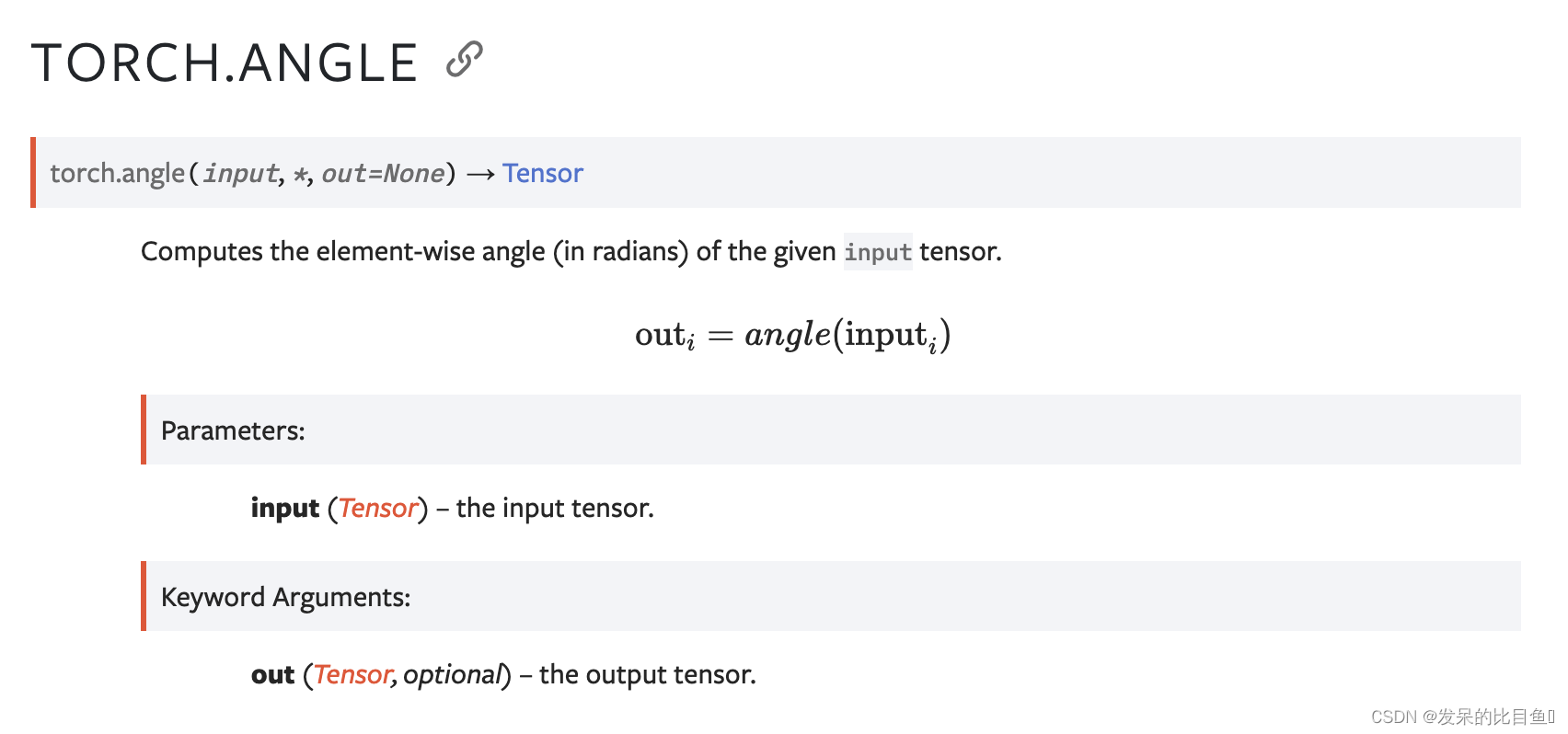
torch.angle(torch.tensor([-1 + 1j, -2 + 2j, 3 - 3j]))*180/3.14159
TORCH.ASIN
返回一个新的张量与输入元素的反正弦值。
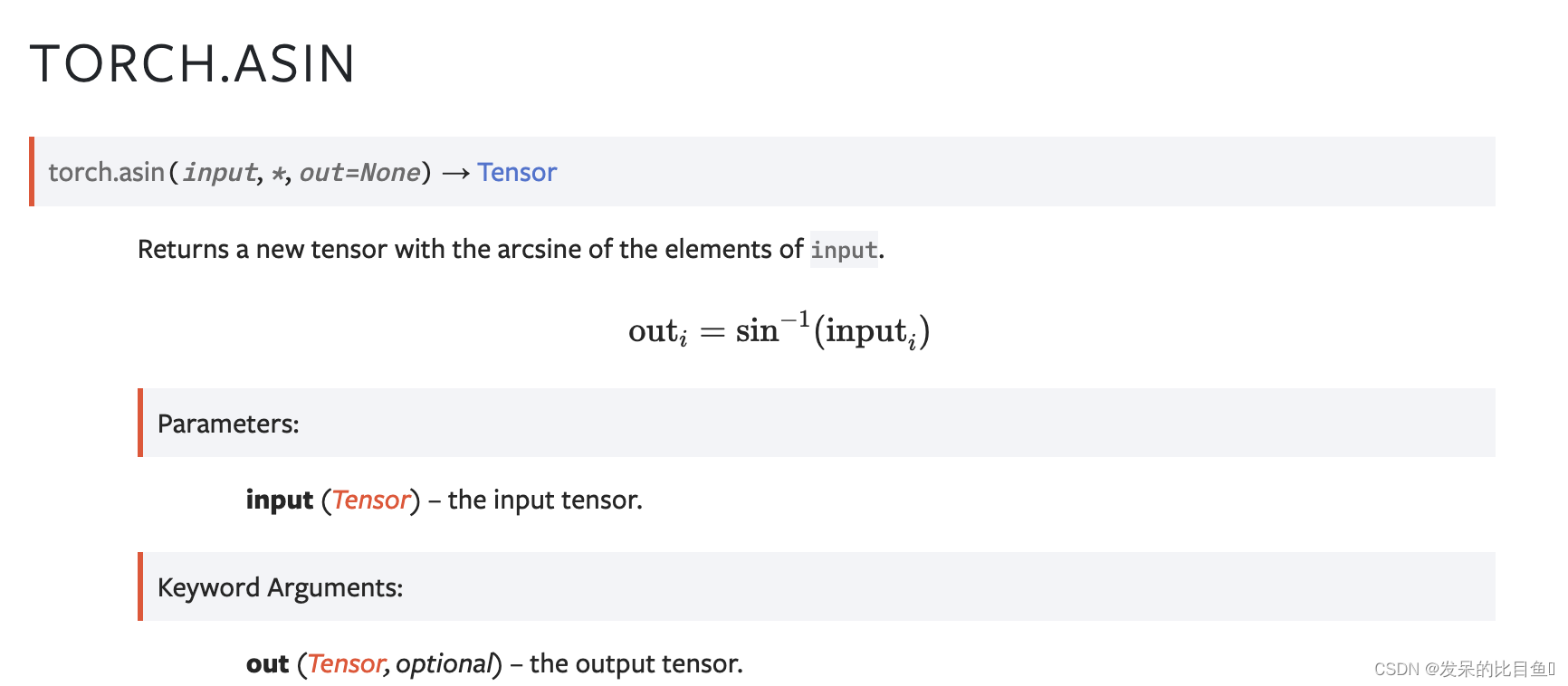
a = torch.randn(4)
a
torch.asin(a)
TORCH.ARCSIN
torch.asin() 的别名。

TORCH.ASINH
返回具有输入元素的反双曲正弦值的新张量。
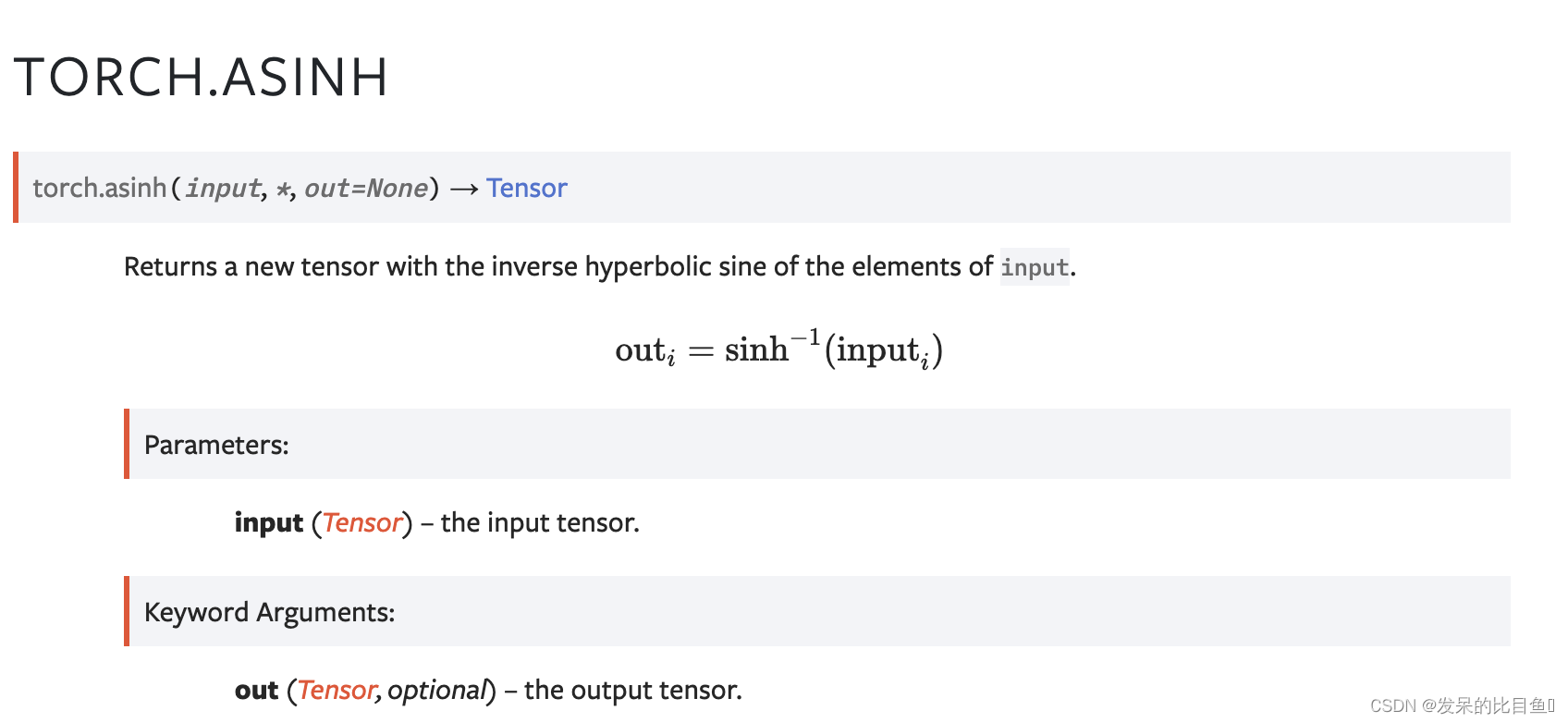
a = torch.randn(4)
a
torch.asinh(a)
TORCH.ARCSINH
torch.asinh()的别名

TORCH.ATAN
返回一个新的张量与输入元素的反正切值。
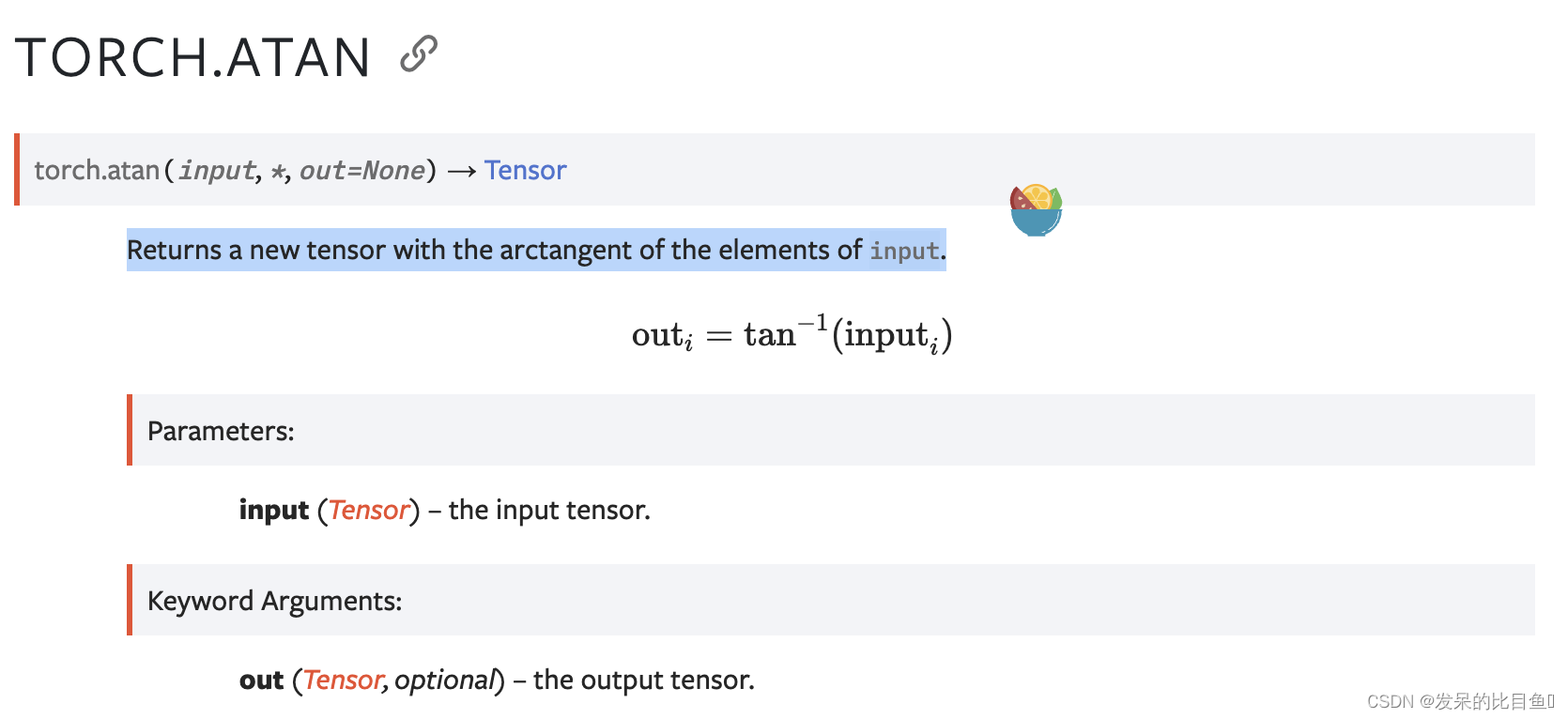
a = torch.randn(4)
a
torch.atan(a)
TORCH.ARCTAN
torch.atan().别名

TORCH.ATANH
返回一个新的张量,该张量具有输入元素的反双曲正切。
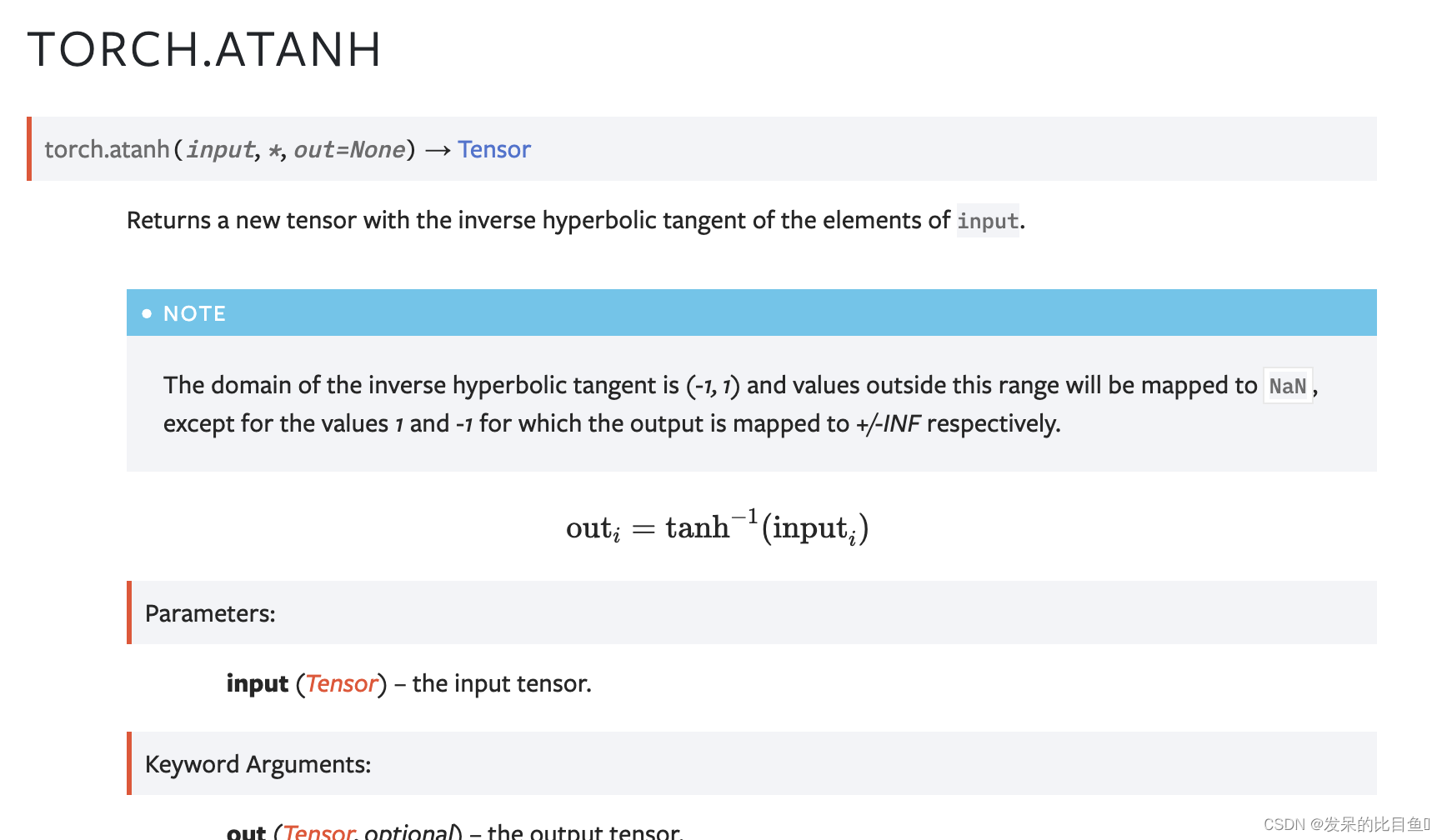
>>> a = torch.randn(4).uniform_(-1, 1)
>>> a
tensor([ -0.9385, 0.2968, -0.8591, -0.1871 ])
>>> torch.atanh(a)
tensor([ -1.7253, 0.3060, -1.2899, -0.1893 ])
TORCH.ARCTANH
torch.atanh().别名

TORCH.ATAN2
考虑象限的input/other元素的反正切。 返回一个新的张量,在向量(other,input)和向量(1,0)之间以弧度表示有符号的角度(注意第二个参数 other 是 x 坐标,而第一个参数 input 是 y-坐标。)
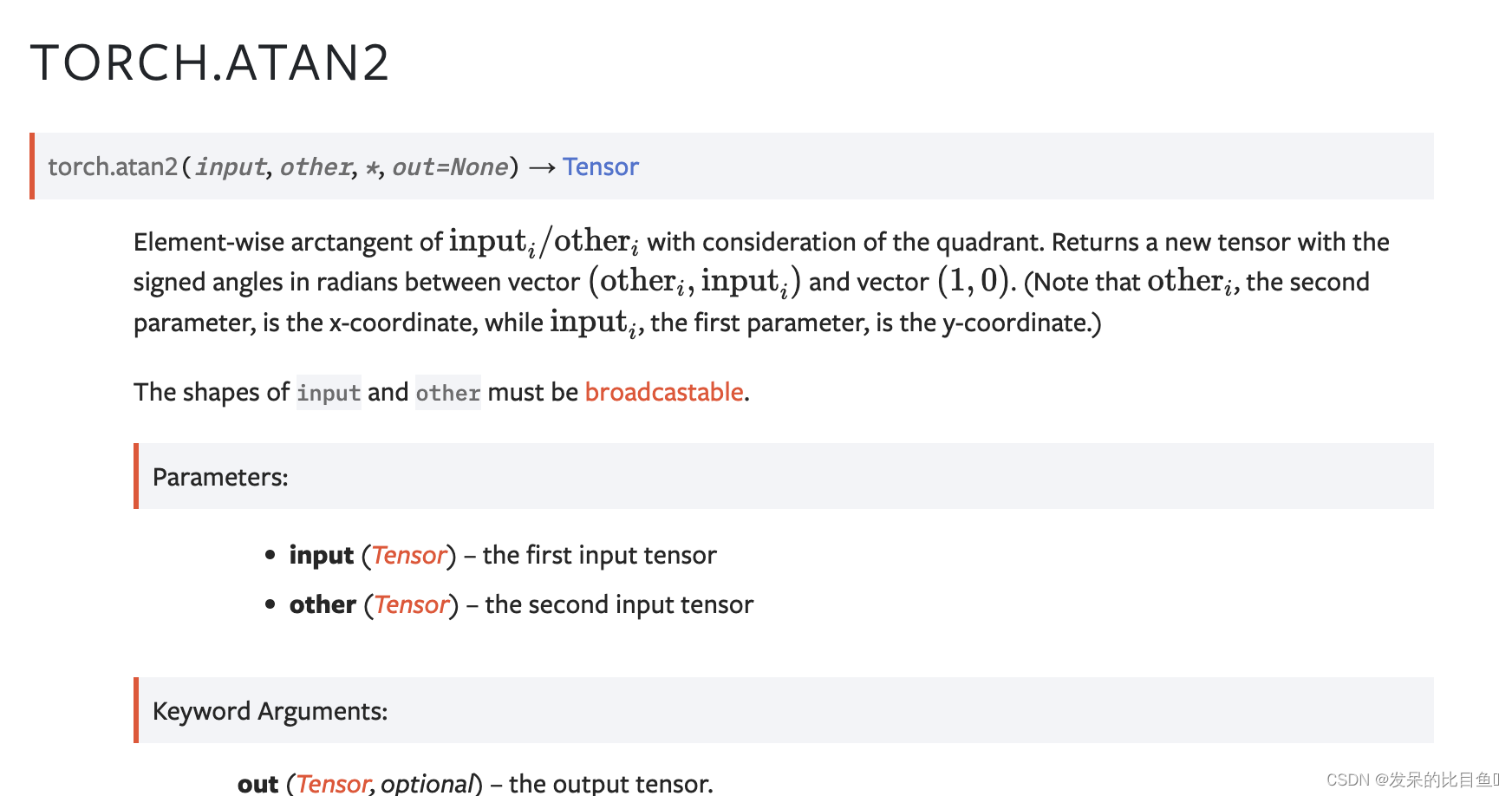
>>> a = torch.randn(4)
>>> a
tensor([ 0.9041, 0.0196, -0.3108, -2.4423])
>>> torch.atan2(a, torch.randn(4))
tensor([ 0.9833, 0.0811, -1.9743, -1.4151])
TORCH.ARCTAN2
torch.atan2() 别名。

TORCH.BITWISE_NOT
计算给定输入张量的按位非。 输入张量必须是整数或布尔类型。 对于 bool 张量,它计算逻辑 NOT。
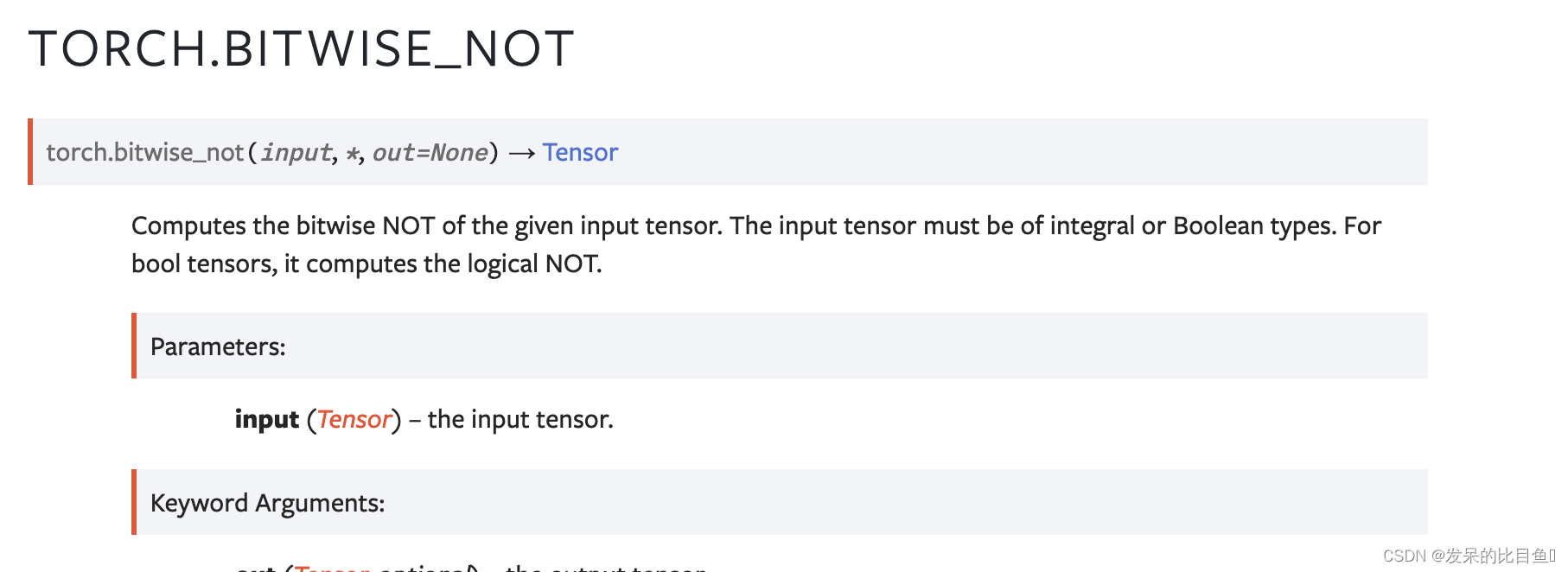
>>> torch.bitwise_not(torch.tensor([-1, -2, 3], dtype=torch.int8))
tensor([ 0, 1, -4], dtype=torch.int8)TORCH.BITWISE_AND
计算输入和其他的按位与。 输入张量必须是整数或布尔类型。 对于布尔张量,它计算逻辑与。

>>> torch.bitwise_and(torch.tensor([-1, -2, 3], dtype=torch.int8), torch.tensor([1, 0, 3], dtype=torch.int8))
tensor([1, 0, 3], dtype=torch.int8)
>>> torch.bitwise_and(torch.tensor([True, True, False]), torch.tensor([False, True, False]))
tensor([ False, True, False])
TORCH.BITWISE_OR
计算输入和其他的按位或。 输入张量必须是整数或布尔类型。 对于布尔张量,它计算逻辑或。
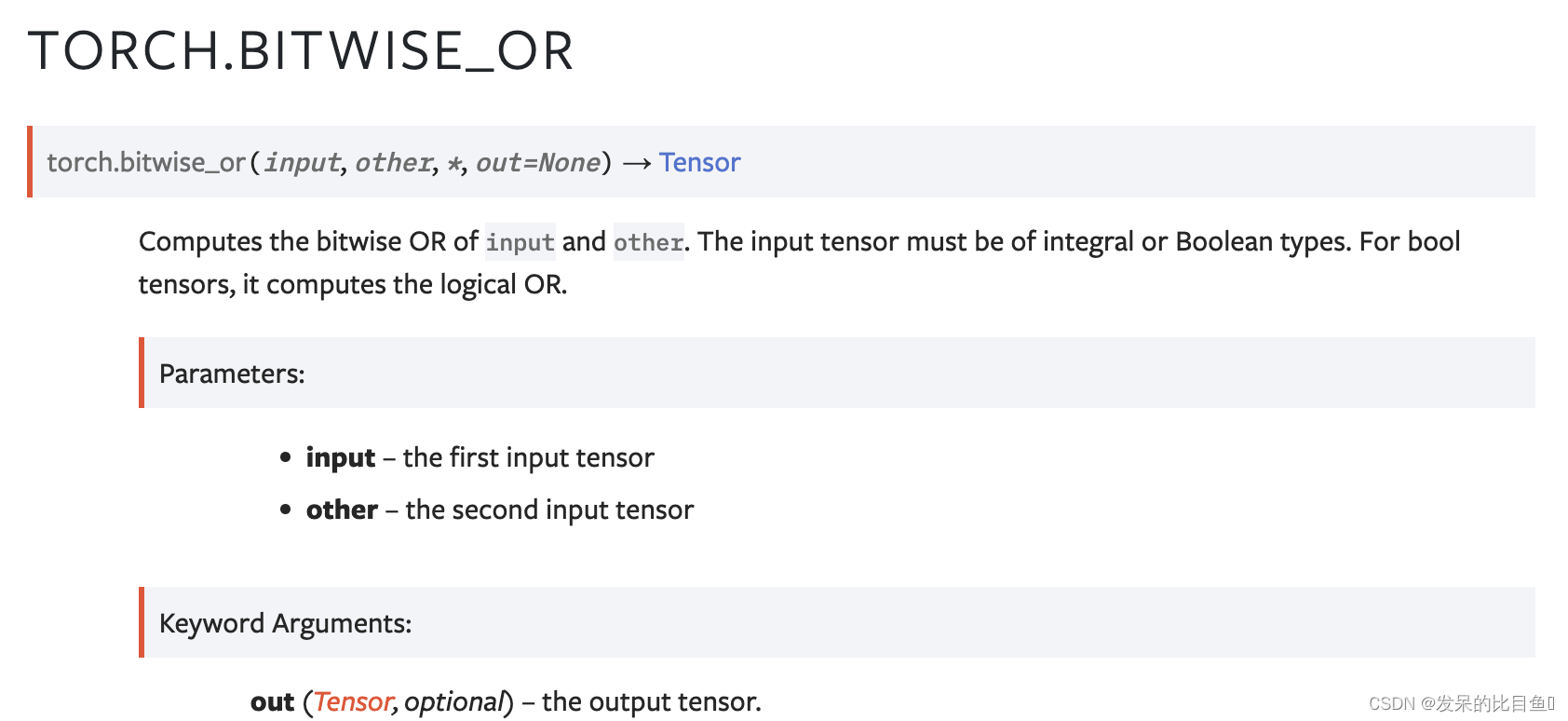
>>> torch.bitwise_or(torch.tensor([-1, -2, 3], dtype=torch.int8), torch.tensor([1, 0, 3], dtype=torch.int8))
tensor([-1, -2, 3], dtype=torch.int8)
>>> torch.bitwise_or(torch.tensor([True, True, False]), torch.tensor([False, True, False]))
tensor([ True, True, False])TORCH.BITWISE_XOR
计算输入和其他的按位异或。 输入张量必须是整数或布尔类型。 对于 bool 张量,它计算逻辑 XOR。
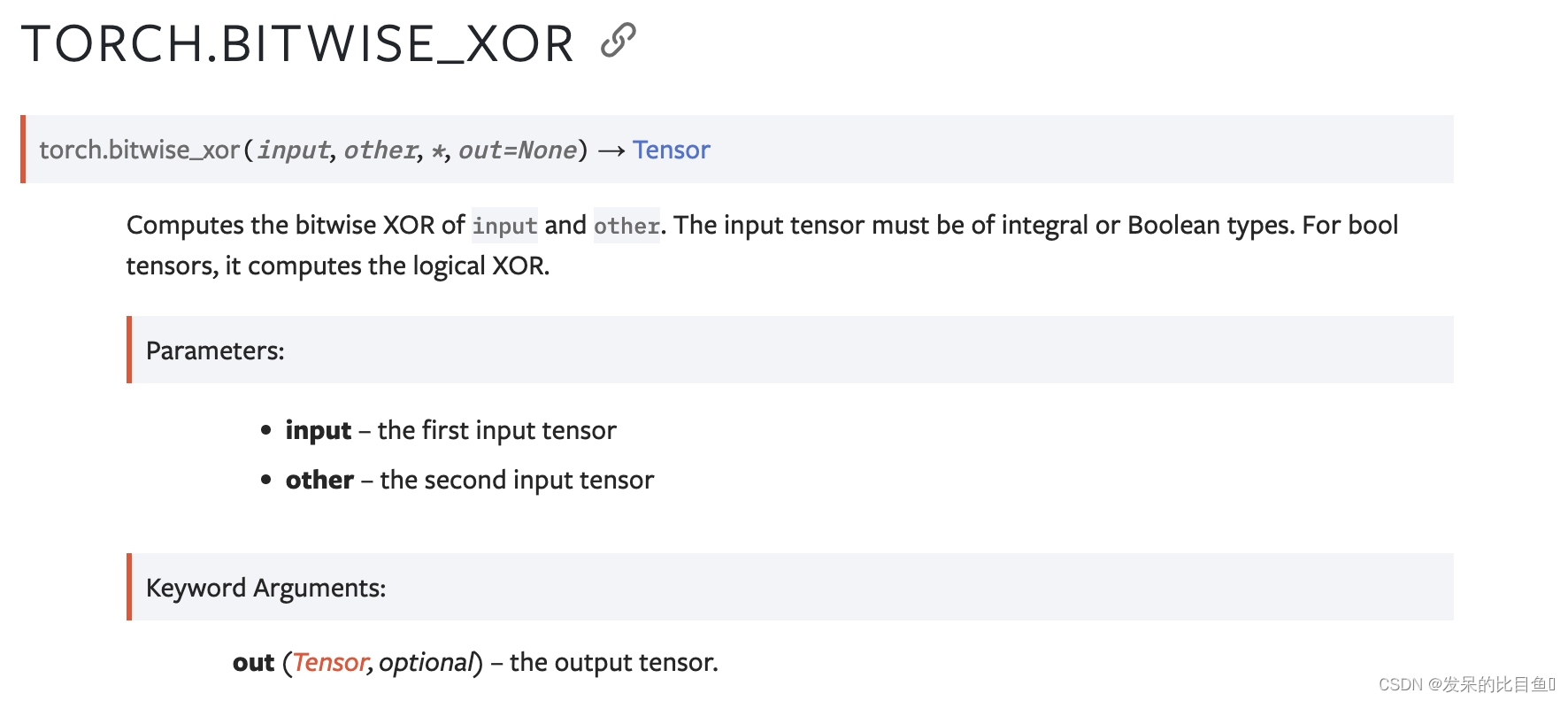
>>> torch.bitwise_xor(torch.tensor([-1, -2, 3], dtype=torch.int8), torch.tensor([1, 0, 3], dtype=torch.int8))
tensor([-2, -2, 0], dtype=torch.int8)
>>> torch.bitwise_xor(torch.tensor([True, True, False]), torch.tensor([False, True, False]))
tensor([ True, False, False])
TORCH.BITWISE_LEFT_SHIFT
计算输入的其他位的左算术移位。 输入张量必须是整数类型。 此运营商支持广播到一个共同的形状和类型推广。
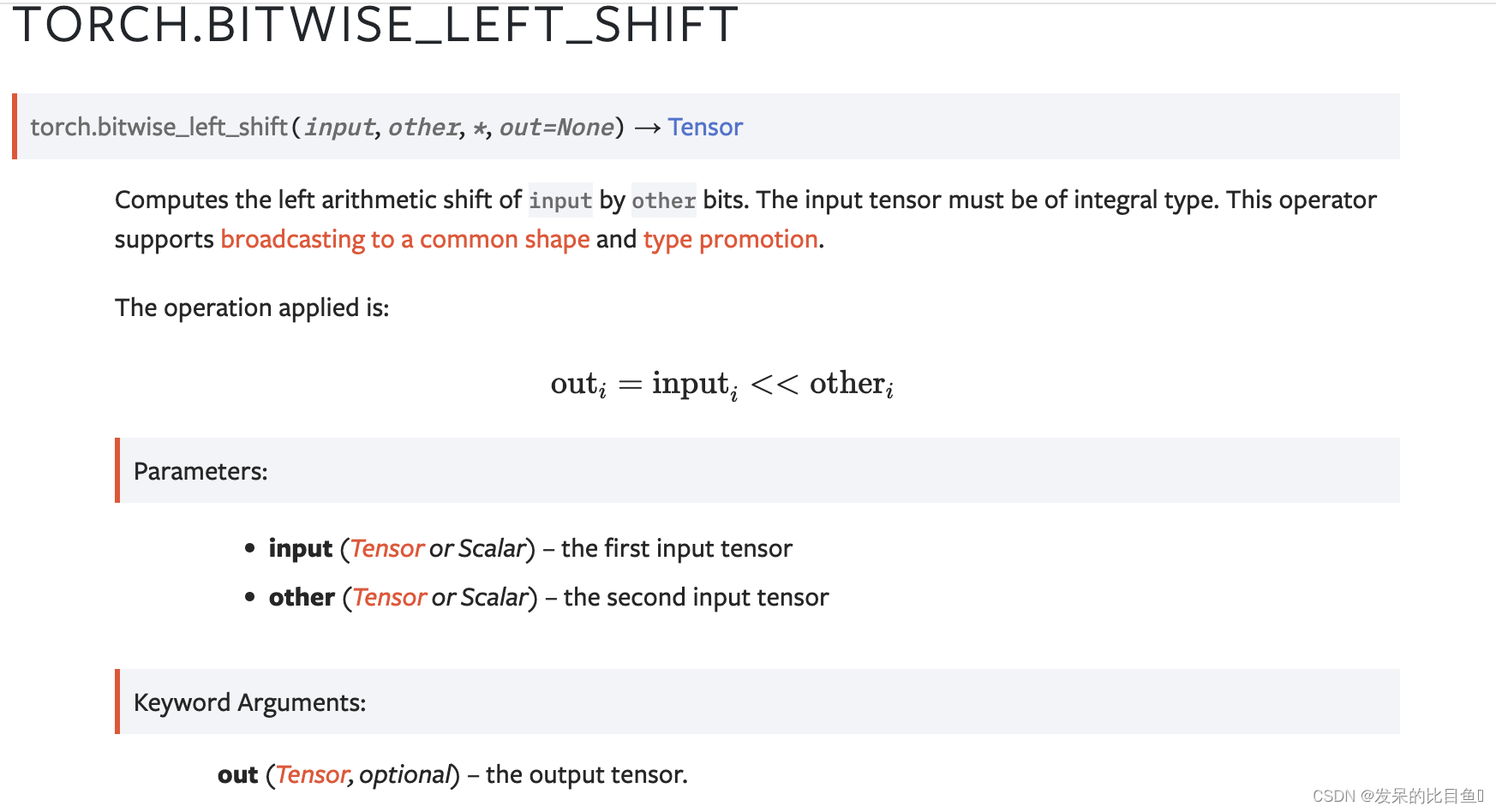
>>> torch.bitwise_left_shift(torch.tensor([-1, -2, 3], dtype=torch.int8), torch.tensor([1, 0, 3], dtype=torch.int8))
tensor([-2, -2, 24], dtype=torch.int8)TORCH.BITWISE_RIGHT_SHIFT
计算其他位输入的算术右移。输入张量必须是积分类型。该运营商支持以普通形状和类型进行广播推广。
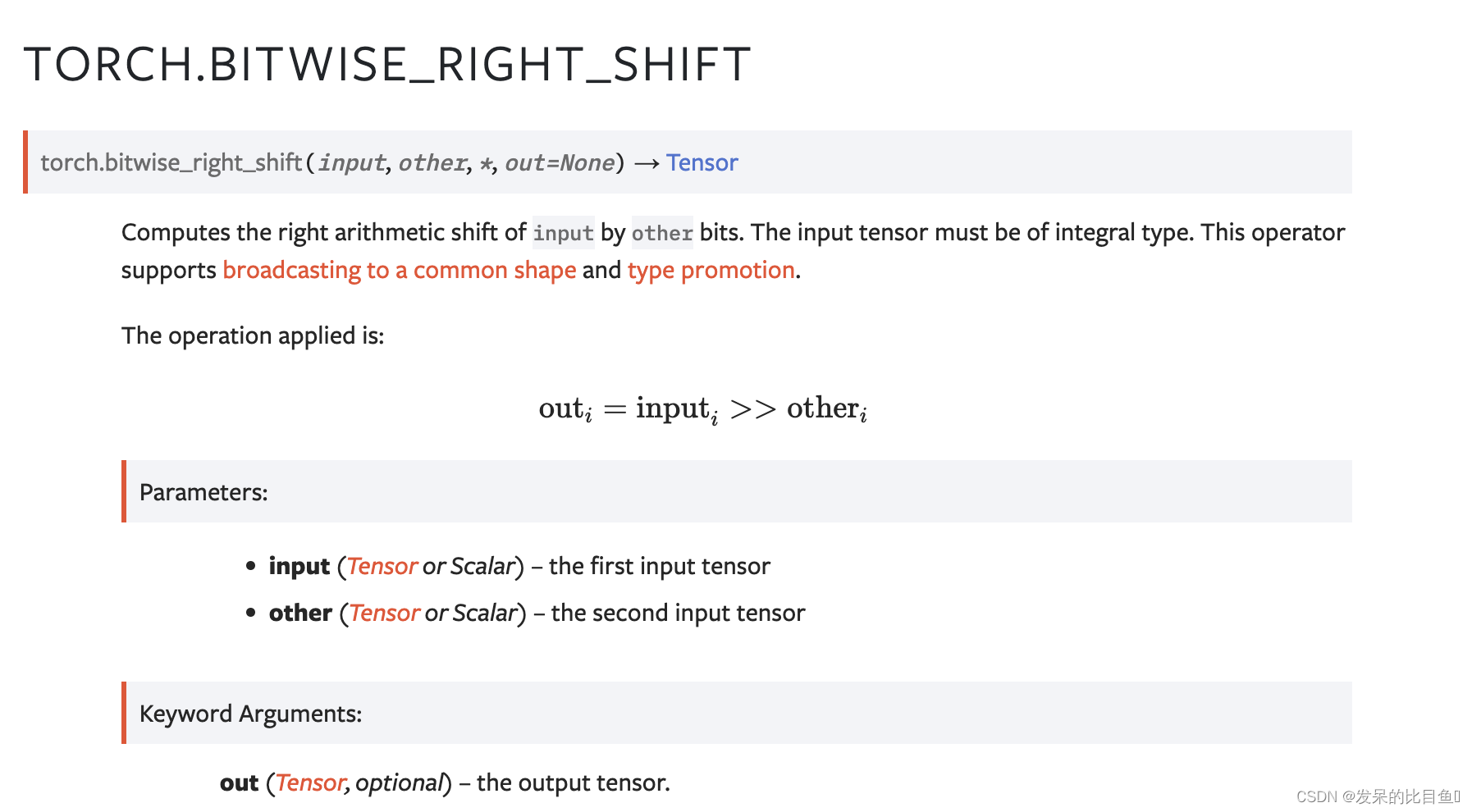
>>> torch.bitwise_right_shift(torch.tensor([-2, -7, 31], dtype=torch.int8), torch.tensor([1, 0, 3], dtype=torch.int8))
tensor([-1, -7, 3], dtype=torch.int8)
TORCH.CEIL
返回一个新的张量,其中包含输入元素的 ceil,即大于或等于每个元素的最小整数。
对于整数输入,遵循返回输入张量副本的 array-api 约定。
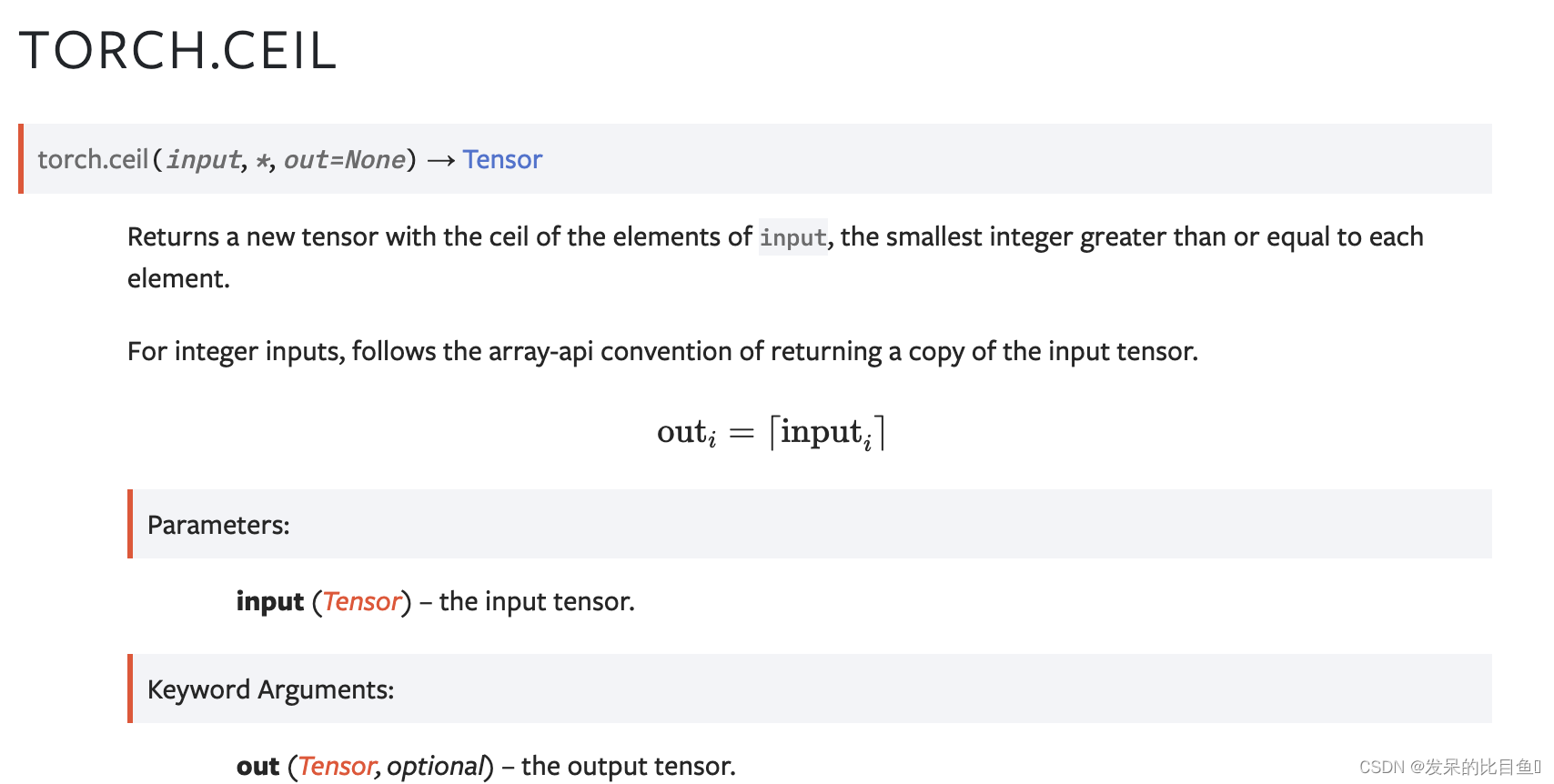
>>> a = torch.randn(4)
>>> a
tensor([-0.6341, -1.4208, -1.0900, 0.5826])
>>> torch.ceil(a)
tensor([-0., -1., -1., 1.])
TORCH.CLAMP
将 input 中的所有元素限制在 [ min, max ] 范围内。 令 min_value 和 max_value 分别为最小值和最大值,返回:
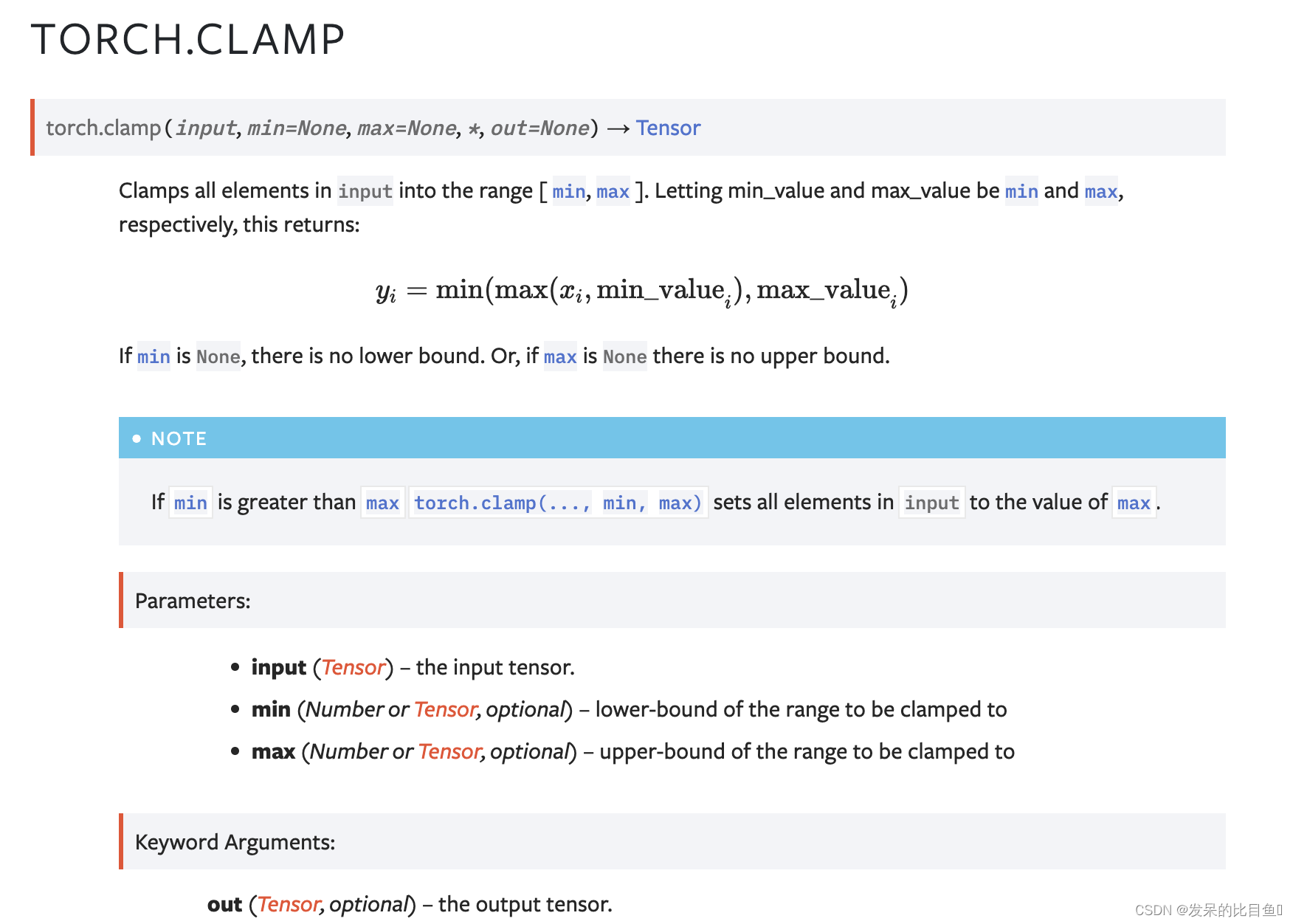
>>> a = torch.randn(4)
>>> a
tensor([-1.7120, 0.1734, -0.0478, -0.0922])
>>> torch.clamp(a, min=-0.5, max=0.5)
tensor([-0.5000, 0.1734, -0.0478, -0.0922])>>> min = torch.linspace(-1, 1, steps=4)
>>> torch.clamp(a, min=min)
tensor([-1.0000, 0.1734, 0.3333, 1.0000])TORCH.CLIP
torch.clamp() 的别名。

TORCH.CONJ_PHYSICAL
计算给定输入张量的逐元素共轭。 如果输入有一个非复杂数据类型,这个函数只返回输入。
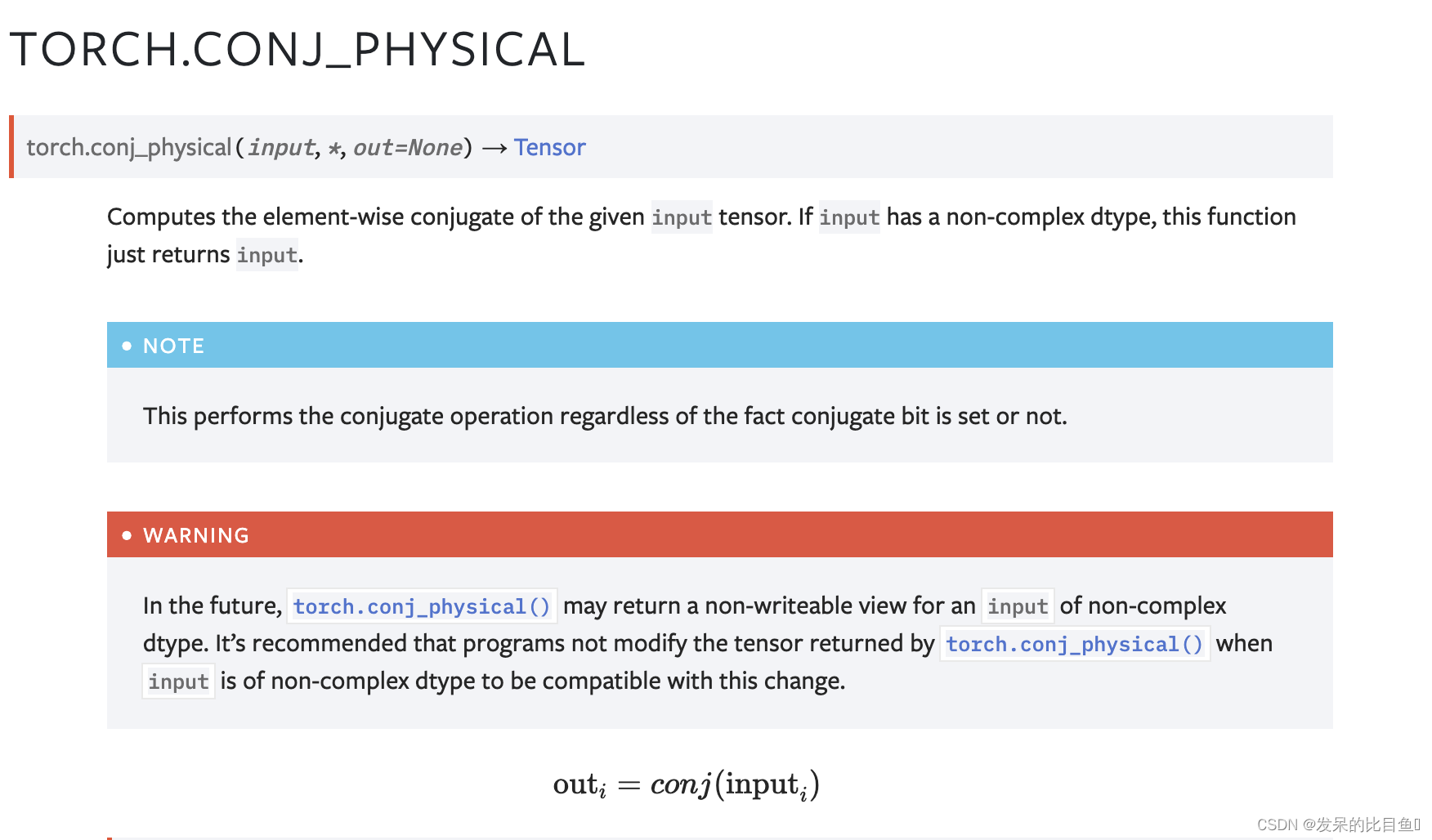

>>> torch.conj_physical(torch.tensor([-1 + 1j, -2 + 2j, 3 - 3j]))
tensor([-1 - 1j, -2 - 2j, 3 + 3j])
TORCH.COPYSIGN
创建一个新的浮点张量,具有输入的大小和其他元素的符号。
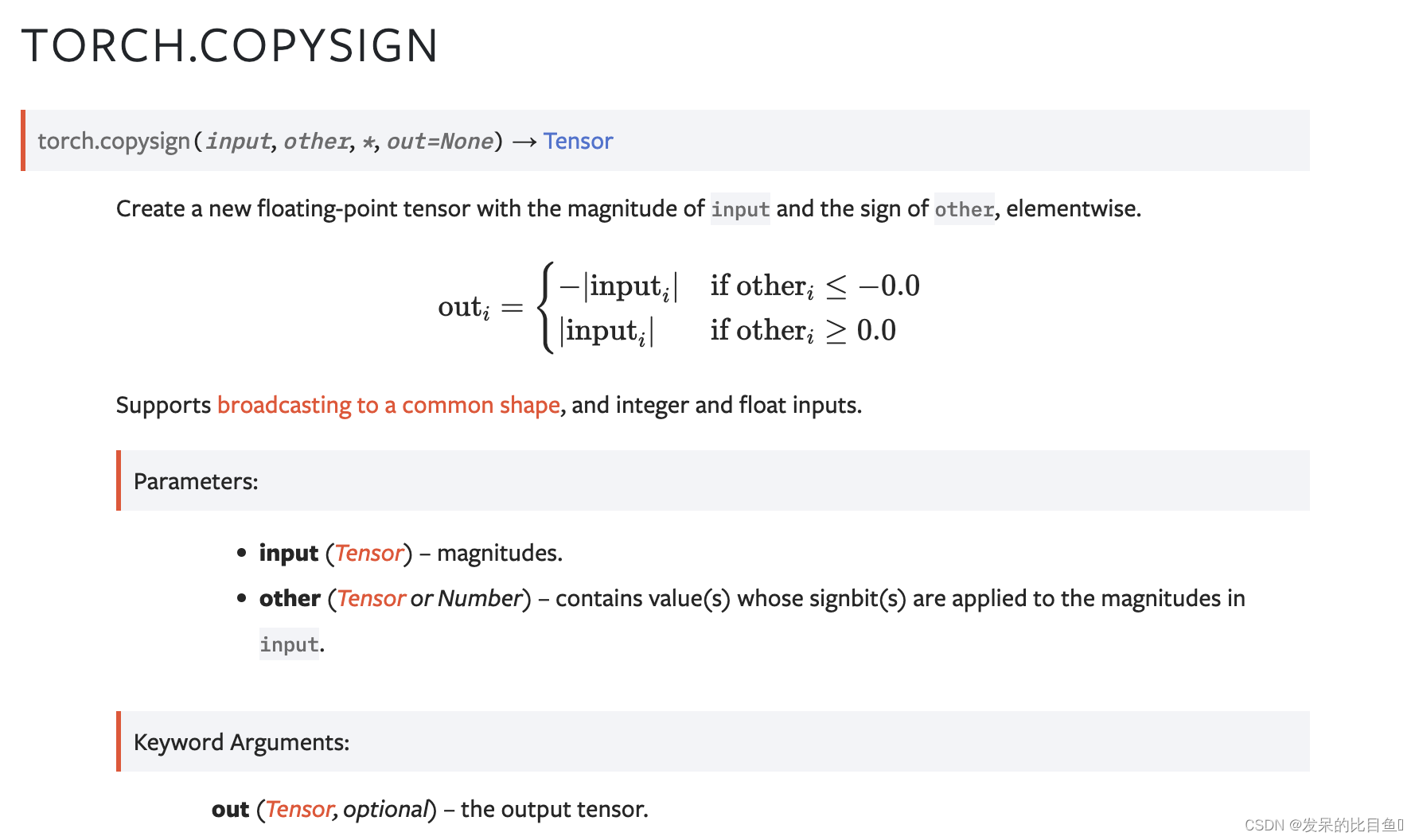
>>> a = torch.randn(5)
>>> a
tensor([-1.2557, -0.0026, -0.5387, 0.4740, -0.9244])
>>> torch.copysign(a, 1)
tensor([1.2557, 0.0026, 0.5387, 0.4740, 0.9244])
>>> a = torch.randn(4, 4)
>>> a
tensor([[ 0.7079, 0.2778, -1.0249, 0.5719],[-0.0059, -0.2600, -0.4475, -1.3948],[ 0.3667, -0.9567, -2.5757, -0.1751],[ 0.2046, -0.0742, 0.2998, -0.1054]])
>>> b = torch.randn(4)
tensor([ 0.2373, 0.3120, 0.3190, -1.1128])
>>> torch.copysign(a, b)
tensor([[ 0.7079, 0.2778, 1.0249, -0.5719],[ 0.0059, 0.2600, 0.4475, -1.3948],[ 0.3667, 0.9567, 2.5757, -0.1751],[ 0.2046, 0.0742, 0.2998, -0.1054]])
>>> a = torch.tensor([1.])
>>> b = torch.tensor([-0.])
>>> torch.copysign(a, b)
tensor([-1.])
TORCH.COS
返回一个新的张量与输入元素的余弦值。
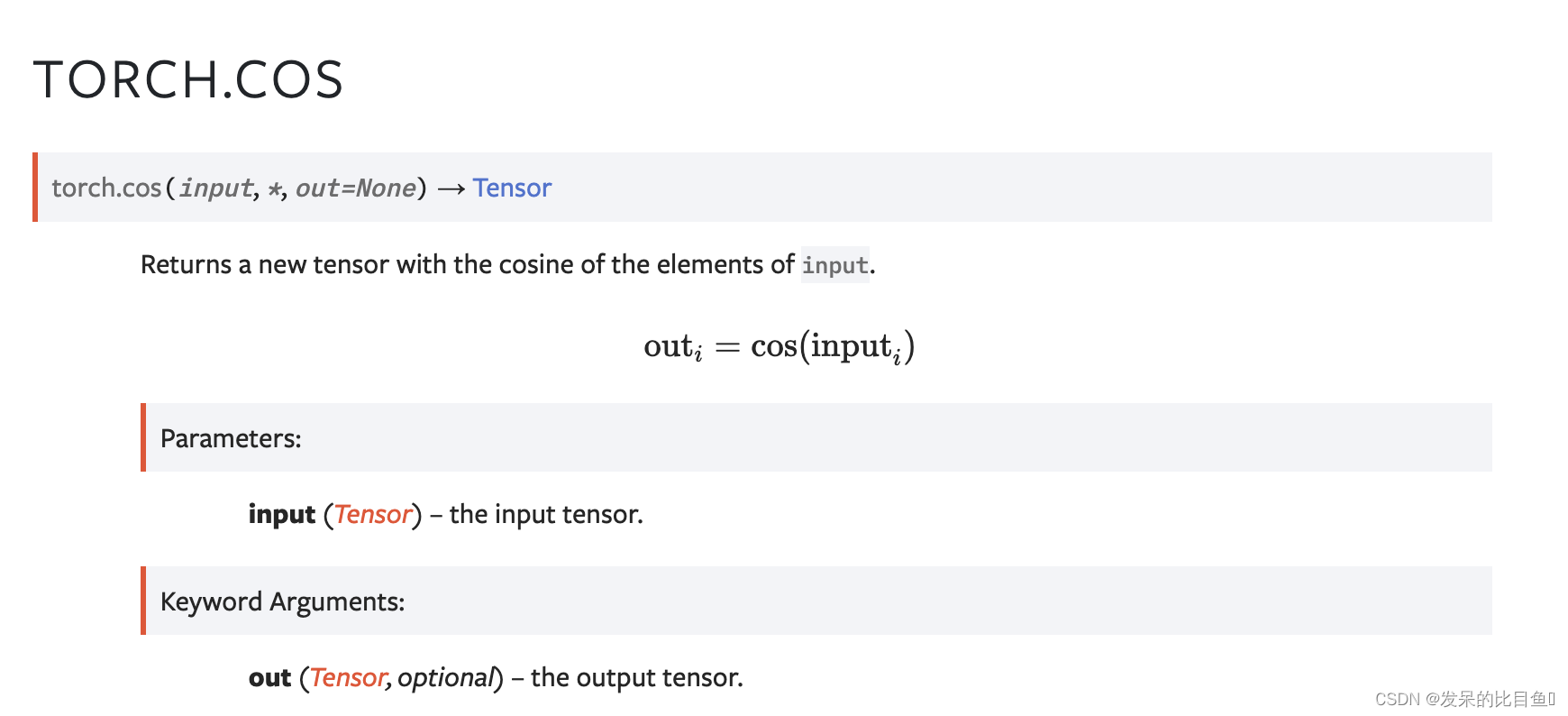
>>> a = torch.randn(4)
>>> a
tensor([ 1.4309, 1.2706, -0.8562, 0.9796])
>>> torch.cos(a)
tensor([ 0.1395, 0.2957, 0.6553, 0.5574])
TORCH.COSH
返回具有输入元素的双曲余弦值的新张量。
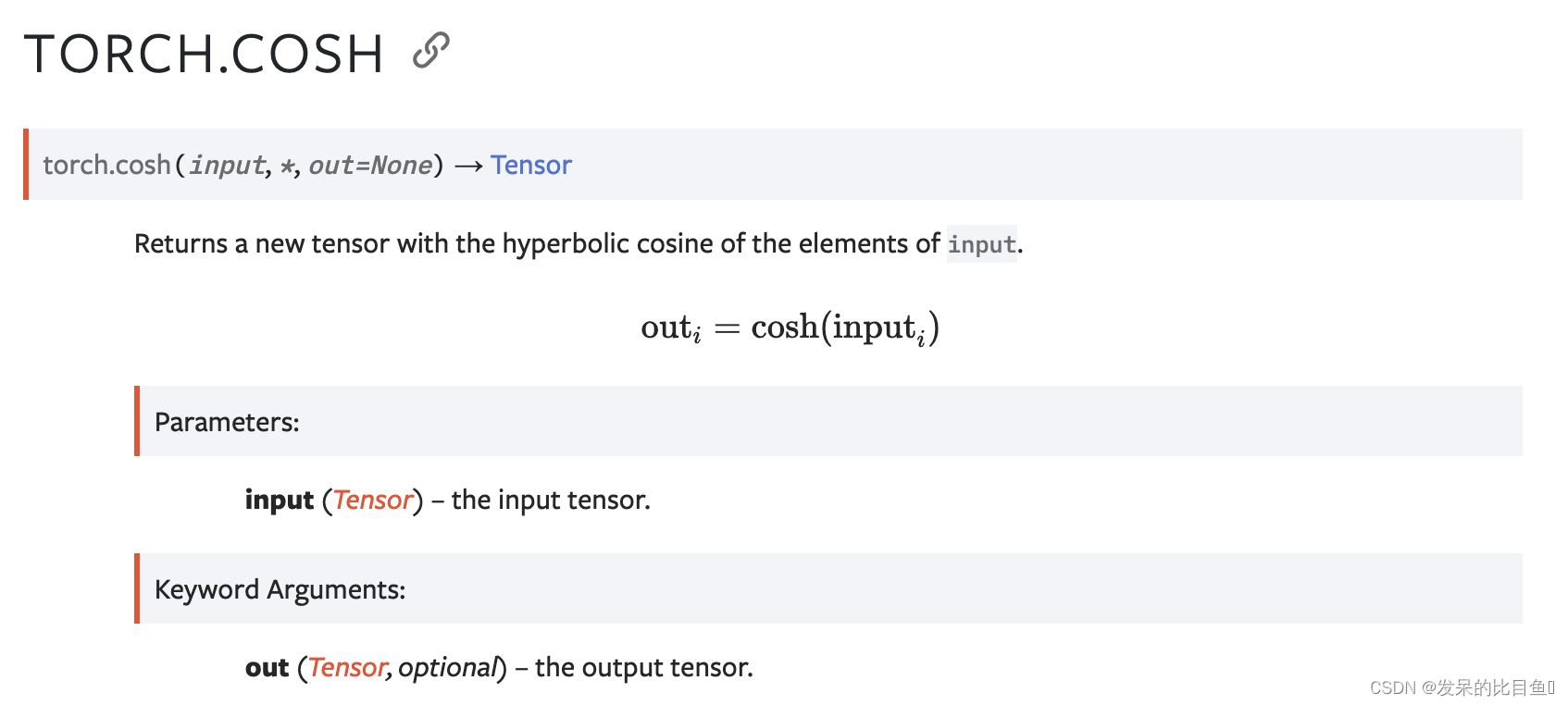
>>> a = torch.randn(4)
>>> a
tensor([ 0.1632, 1.1835, -0.6979, -0.7325])
>>> torch.cosh(a)
tensor([ 1.0133, 1.7860, 1.2536, 1.2805])
TORCH.DEG2RAD
返回一个新的张量,其中输入的每个元素都从以度为单位的角度转换为弧度。
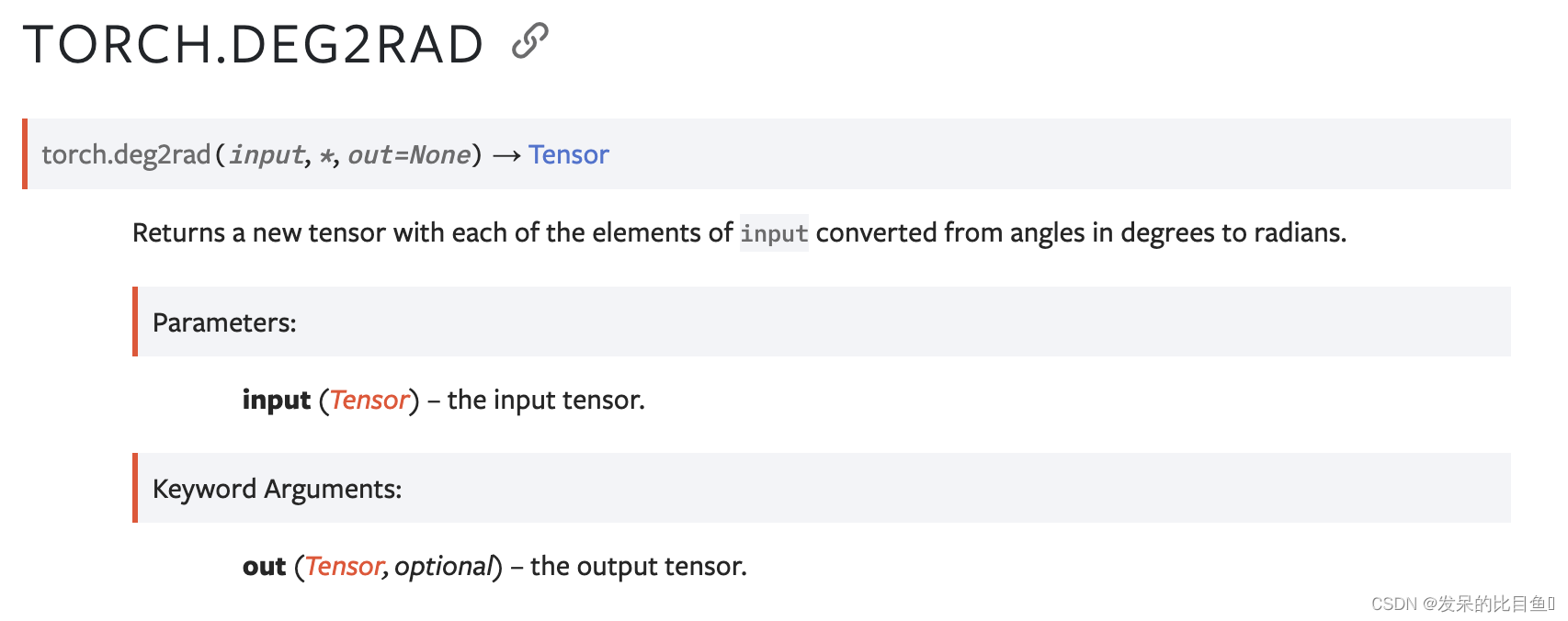
>>> a = torch.tensor([[180.0, -180.0], [360.0, -360.0], [90.0, -90.0]])
>>> torch.deg2rad(a)
tensor([[ 3.1416, -3.1416],[ 6.2832, -6.2832],[ 1.5708, -1.5708]])
TORCH.DIV
将输入 input 的每个元素除以 other 的对应元素。
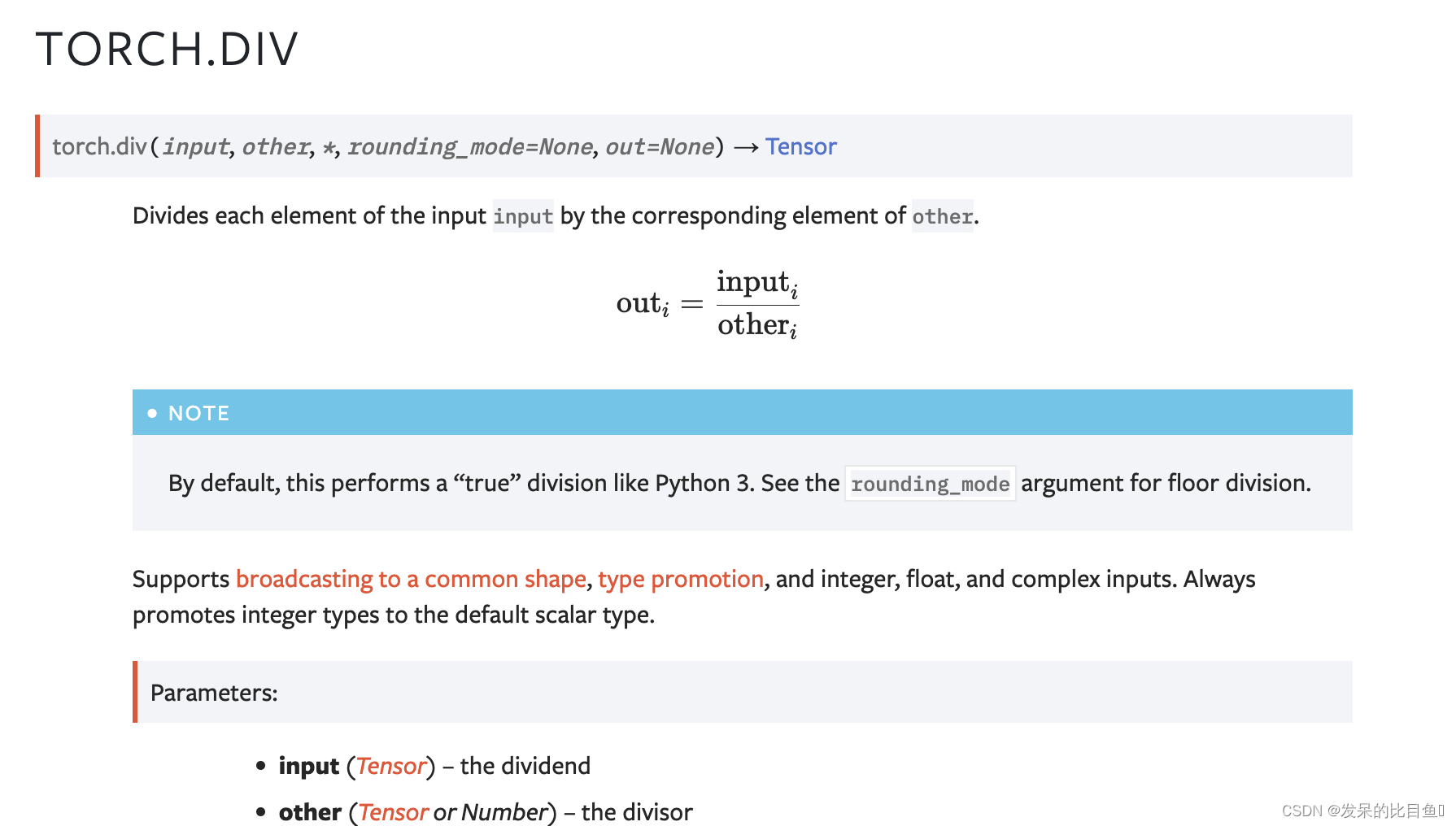
>>> x = torch.tensor([ 0.3810, 1.2774, -0.2972, -0.3719, 0.4637])
>>> torch.div(x, 0.5)
tensor([ 0.7620, 2.5548, -0.5944, -0.7438, 0.9274])>>> a = torch.tensor([[-0.3711, -1.9353, -0.4605, -0.2917],
... [ 0.1815, -1.0111, 0.9805, -1.5923],
... [ 0.1062, 1.4581, 0.7759, -1.2344],
... [-0.1830, -0.0313, 1.1908, -1.4757]])
>>> b = torch.tensor([ 0.8032, 0.2930, -0.8113, -0.2308])
>>> torch.div(a, b)
tensor([[-0.4620, -6.6051, 0.5676, 1.2639],[ 0.2260, -3.4509, -1.2086, 6.8990],[ 0.1322, 4.9764, -0.9564, 5.3484],[-0.2278, -0.1068, -1.4678, 6.3938]])>>> torch.div(a, b, rounding_mode='trunc')
tensor([[-0., -6., 0., 1.],[ 0., -3., -1., 6.],[ 0., 4., -0., 5.],[-0., -0., -1., 6.]])>>> torch.div(a, b, rounding_mode='floor')
tensor([[-1., -7., 0., 1.],[ 0., -4., -2., 6.],[ 0., 4., -1., 5.],[-1., -1., -2., 6.]])
TORCH.DIVIDE
torch.div() 的别名

TORCH.DIGAMMA
Torch.special.digamma()的别名。

TORCH.ERF
torch.special.erf()的别名。

TORCH.ERFC
Torch.special.erfc() 的别名。

TORCH.ERFINV
torch.special.erfinv()的别名。

